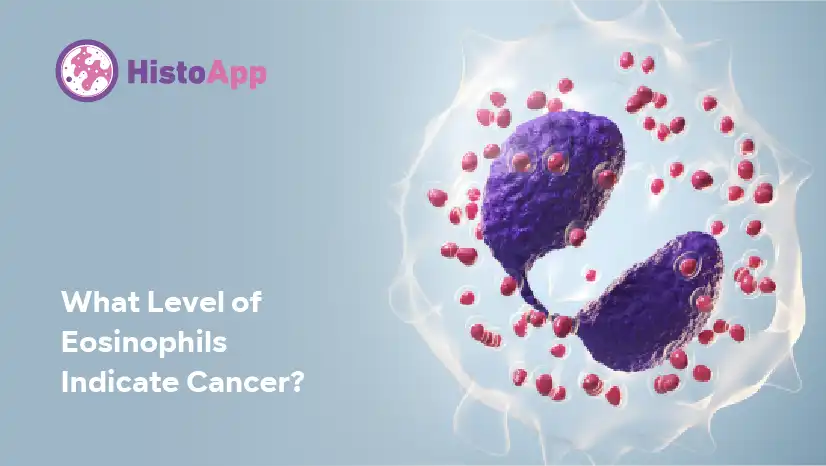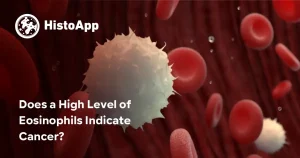


13 Apr 2025
Eosinophils are a type of white blood cell that play a crucial role in the immune system. They help fight infections, particularly parasitic ones and are involved in allergic reactions and inflammation. However, when eosinophils are high, it can sometimes indicate more serious conditions, including cancer.
In this article, we’ll explore the eosinophils’ meaning, the causes of high eosinophilia, and specifically, what level of eosinophils indicates cancer.
Eosinophils are a type of white blood cell (leukocytes) that support your immune system and protect your body from parasites, allergens, and foreign bacteria. While they are a small percentage of total white blood cells, their functions are vital for protecting the body from infections and regulating immune responses.
Eosinophils are involved in inflammatory processes, which can be both protective (helping your body heal) and harmful (contributing to chronic conditions). They interact with other immune cells to help your body respond to threats, such as infections or foreign substances.
There are three types of white blood cells: granulocytes (neutrophils, eosinophils, and basophils), monocytes, and lymphocytes (T cells and B cells). Eosinophils play an important role in preventing foreign organisms from growing inside host cells (parasites).

If eosinophil levels are high in the blood, it is called blood eosinophilia.
There are several conditions and events that may increase eosinophils in the human body, including:
1. Allergic Reactions:
Conditions like asthma, hay fever, or eczema can make your body produce more eosinophils.
2. Parasitic Infections:
Eosinophils are particularly effective at fighting parasitic infections caused by worms, lice, or plasmodia, and they can often produce more eosinophils to combat the invaders.
3. Autoimmune Diseases
Autoimmune diseases occur when your immune system mistakenly attacks your own tissues. Some autoimmune conditions that can cause eosinophilia include Rheumatoid arthritis, lupus, and eosinophilic granulomatosis with polyangiitis (EGPA).
4. Drug allergies:
There are some drugs that can potentially trigger allergic reactions and increase the level of eosinophils, including a serious medical condition known as drug rash with eosinophilia and systemic symptoms (DRESS) syndrome. DRESS syndrome is a serious and potentially fatal reaction that can affect other organs, including your liver and lymph nodes. Certain drugs, such as antibiotics or anti-seizure drugs, can also cause eosinophils to rise.
5. Cancers
There are several kinds of cancers, particularly blood cancers, that are known for increasing the eosinophil count, including leukaemia, breast, colorectal, ovary, prostate, cervix, blood, and lymph node cancers.

Absolute eosinophils or high eosinophils mean that the immune system is fighting some kind of infection from a virus, bacteria, or fungus or experiencing an allergic reaction.
If an eosinophil counts higher than the normal range (over 500 cells per microliter), it may indicate cancer, particularly if it is persistent and accompanied by other symptoms. However, it’s important to note that eosinophilia alone is not a definitive sign of cancer. There are several non-cancerous conditions, including infections, allergic reactions, and autoimmune diseases, that can also lead to elevated eosinophil levels.
When eosinophilia is associated with cancer, it typically occurs alongside other clinical symptoms such as unexplained weight loss, fatigue, and persistent pain, which are common signs of malignancy.
Here are Some Common Cancers Linked to High Levels of Eosinophils:
Leukemia is a white blood cell cancer characterized by a high number of white blood cells called eosinophils in the blood. These cells combat infections caused by parasites and contribute to inflammation in allergic reactions.
High eosinophils are a key characteristic of certain types of leukemia, including chronic and acute eosinophilic leukemia, both of which are very rare diseases. However, eosinophils can also be raised in other cancers of the blood and lymph nodes.
Breast cancer is one of the most common cancers that usually affects women. It occurs when cancerous cells multiply and form tumours in the breasts. About 80% of breast cancer cases are invasive, which means a tumour may spread from the breast to other areas of your body.
A study found that the presence of numerous eosinophils around colorectal tumours is associated with a better prognosis and higher chances of successful treatment.
Eosinophils in the tumour microenvironment may enhance the immune system’s ability to attack cancer cells, leading to improved outcomes.
Hodgkin lymphoma, also known as Hodgkin disease, is a group of blood cancer cells that develop in the lymphatic system. It’s one of two main types of lymphoma. The other type is non-Hodgkin lymphoma. These cancers affect important white blood cells in the immune system called lymphocytes.

Eosinophils are very important to protect the immune system, but abnormal levels can signal underlying health issues, including infections, allergies, and even cancer. A high level of eosinophils, or eosinophilia, requires careful evaluation to determine the cause and appropriate treatment.
Whether it’s through a simple eosinophils blood test or a comprehensive analysis using pathology laboratory techniques, understanding the level of eosinophils is key to ensuring accurate diagnoses and effective treatments.
Modern pathology labs, equipped with digital pathology tools and advanced pathology software, play a critical role in diagnosing and monitoring conditions related to eosinophils.
In the evolving field of healthcare, HistoApp is transforming cancer care by utilising advanced digital pathology tools and pathology software to create comprehensive cancer registries.
These registries offer valuable insights into cancer facts, treatment outcomes, and patient care, benefiting healthcare providers, researchers, and patients.
HistoApp utilises advanced technology to enhance cancer diagnosis, treatment, and research, ultimately resulting in improved outcomes for patients.
Read More About:

- OR -
You can make us a free call through our website, press the button below and start the call
Call Us now